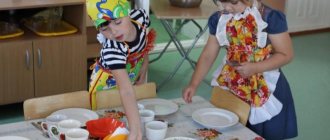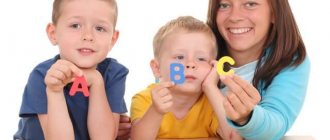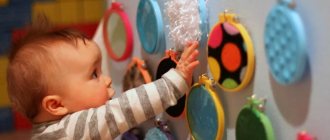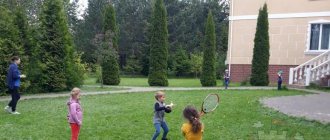Pedagogical activities aimed at the comprehensive development of the child’s personality will be more effective if they are built in accordance with the nature, culture of the child and the teacher.
In the course of pedagogical activity, a special communication arises between the teacher and the child, in which the participants find their own view of the world. The task of pedagogical activity in the context of a dialogue between the cultures of the teacher and the child is twofold: on the one hand, to strengthen and develop the child’s ways of thinking, position, and picture of the world; on the other hand, organize interaction with another culture (an adult).
The leading role of the teacher (adult), organizing the process of raising and educating a child, is quite fully defined in the studies of A.V. Zaporozhets, P.Ya. Galperina, L.A. Wenger et al. S.L. Rubinstein repeatedly emphasized that the pedagogical process shapes the child’s personality to the extent that the teacher guides his activity and does not replace it. Similar conclusions are contained in the works of V.S. Merlina, J. Strelyau, A.B. Nikolaeva, A.V. Petrovsky, R. Burns and others.
The most general task of pedagogical activity in the educational process is to create conditions for the harmonious development of the individual, to prepare the younger generation for work and other forms of participation in the life of society. It is solved by organizing a personally developing environment, managing various activities of students and building correct interaction with the child.
In pedagogical science, there are two types of interaction between teacher and child: subject-object and subject-subject.
1. Subject-object relations. In pedagogical activity, the role of the subject is the teacher, and the role of the object is the student (child).
The teacher as a subject of pedagogical activity is characterized by goal setting, activity, pedagogical self-awareness, adequacy of self-esteem and level of aspirations, etc. In this situation, the child acts as a performer of the requirements and tasks set by the teacher. With reasonable subject-object interaction, the positive qualities of children are formed and consolidated: diligence, discipline, responsibility; The child accumulates experience in acquiring knowledge, masters the system, the orderliness of actions. However, as long as the child is the object of the pedagogical process, i.e., the motivation for activity constantly comes from the teacher, the child’s cognitive development will not be effective. A situation where there is no need to show initiative and limited independence often creates negative aspects of the personality. The teacher “sees” his students in a very one-sided way, mainly from the point of view of compliance/non-compliance with the norms of behavior and the rules of the organized activity.
2. Subject-subject relationships contribute to the development in children of the ability to cooperate, initiative, creativity, and the ability to constructively resolve conflicts.
The most complex work of thought processes and imagination is activated, knowledge is activated, the necessary methods are selected, and various skills are tested. All activities acquire personal significance for the child, valuable manifestations of activity and independence are formed, which, with a sustainable strengthening of the subject position, can become his personal qualities. During subject-subject interaction, the teacher understands his students more personally; such interaction is called personality-oriented. A personality-oriented teacher maximizes the development of the child’s ability to realize his “I” in connections with other people and the world in its diversity, to comprehend his actions, to foresee their consequences, both for others and for himself. Pedagogical activity in this kind of interaction is dialogical in nature. M. Bakhtin believes that a child only in dialogue, entering into interaction with another subject, gets to know himself, through comparison with another, through a comparison of his choice and his own choice.
The nature of the interaction between the teacher and the child determines the style of pedagogical activity. In domestic science, the works of I. V. Strakhov, N. D. Levitov, E. A. Klimov, V. E. Chudnovsky, V. I. Morosanov and others are devoted to the study of this problem.
A.K. Markov differentiates democratic, authoritarian and liberal styles of pedagogical activity and describes them as follows.
With a democratic style of pedagogical activity, the child is considered as an equal partner in communication and cognitive activity. The teacher involves children in decision-making, takes into account their opinions, encourages independent judgment, and takes into account not only academic performance, but also personal qualities. Methods of influence are encouragement to action, advice, request. Teachers with a democratic style of interaction are characterized by greater professional stability and satisfaction with their profession.
With an authoritarian style, the child is viewed as an object of pedagogical influence, and not an equal partner. The teacher makes decisions alone, establishes strict control over the fulfillment of the requirements placed on him, uses his rights without taking into account the situation and opinion of the child, and does not justify his actions to him. As a result, children lose activity or carry it out only when the teacher plays a leading role, and exhibit low self-esteem and aggressiveness. The main methods of influence of this style are orders and teachings. Teachers are characterized by low satisfaction with their profession and professional instability.
With a liberal style, the teacher moves away from making decisions, transferring the initiative to children and colleagues. Organizes and controls the activities of children without a system, shows indecision and hesitation.
Each of these styles, identifying the attitude towards the interaction partner, determines its character: from subordination, following - to partnership and to the absence of directed influence. It is important that each of these styles presupposes the dominance of either monologue or dialogic forms of communication.
MAGAZINE Preschooler.RF
SUBJECT-SUBJECT INTERACTION OF PARTICIPANTS IN THE EDUCATIONAL PROCESS OF A PRE-SCHOOL EDUCATIONAL ORGANIZATIONN.V. Nasurova, Chelyabinsk
SUBJECT-TO-SUBJECT INTERACTION IN THE EDUCATIONAL PROCESS AT PRESCHOOL ORGANIZATION NV Nasurova
The article is devoted to the problem of the relationship between teacher and student. The author examines the features of subject-subject interaction between participants in the educational process; analyzes the main elements of humane subject-subject relations between teacher and student.
The article is devoted to the problem of relations between a teacher and a student. The author deals with features of the subject-to-subject interaction among participants of training and research activities; analyzes some basic elements of humane subject-to-subject relations between a teacher and a student.
Keywords:
subject-subject interaction in the “teacher-pupil” , humane subject-subject relations.
Keywords:
subject-to-subject interaction in the theme “teacher – student”, humane subject-to-subject relations.
The main goal of subject-subject interaction is the development of the student’s personality, which is the main value of the educational process in a preschool educational institution. The function of the teacher is to organize the learning environment and create conditions for personal development. Subject-subject relations between participants in the educational process have the following characteristic features:
- active position of the student in the process of activity
- joint problem solving as ways of interaction
- game, dialogue, work in microgroups as the main organizational forms that implement humanistic relationships
- the permissibility of the coexistence of opposing points of view.
The advantages of subject-subject interaction were experimentally proven by V. V. Davydov, L. V. Zankov, D. B. Elkonin within the framework of developmental education systems and identified empirically by innovative teachers Sh. A. Amonashvili, E. N. Ilyin and others .
Subject-subject interaction presupposes:
- the desire of students to develop a problematic vision
- encouraging students to ask questions
- establishing similarities between different phenomena or hidden differences between the original phenomena.
Having analyzed the materials of E.V. Bondarevskaya, E.N. Krolevetskaya, O.S. Ulyanova [1], we came to the conclusion that subject-subject interaction presupposes the development of humanistic relations between teacher and student in the holistic educational process.
Trusting relationships between teacher and student play an important role in building humane relationships. Trusting relationships are relationships of mutual respect, naturalness and openness. The criterion for ensuring trust between teacher and student is . ”
Trusting relationships between participants in the educational process contribute to the full development of the student and the implementation of the research skills of each individual.
Cooperation in the language of psychological science is the organization of subject-subject relations in joint activities. Its most important features are:
- awareness of a common goal, which mobilizes the teacher and student
- high organization of joint activities of participants in the educational process, their common efforts
- mutual trust, goodwill, mutual assistance in case of difficulties.
- interaction of students with each other, their business communication and collective responsibility for the result of common activities.
Cooperation is not an end in itself; it is established so that the student gains knowledge and skills, experience in communication and social activity.
One of the tasks of the teacher is to intensify the activities of students and manage their activity. In other words, the teacher must constantly encourage students to energetic and purposeful learning, using various ways to activate motivational resources. Scientists (A.A. Petrusevich, M.N. Shabarova, I.Yu. Serousov [4]) identify incentives for intensifying educational activities of students: encouragement and their desire for new achievements.
One of the strong motives of the educational process is interest. In his studies, L. S. Vygotsky notes that the interest of pupils should not be associated only with praise, fear, the desire to please, etc. The interest of pupils, in his opinion, arises and persists if the educational system is built “in close proximity to life, teaches children what interests them, starts with what is familiar to them and naturally arouses interest” [5].
It is fundamentally important that every time the student experiences the joy of discovery, so that he develops faith in his own strengths and cognitive interest. The interest of students is related to the level and quality of acquired knowledge, the level of developed methods of mental activity.
Personal attitudes of the teacher that are most adequate to humanistic teaching. We highlight the following as the main personal attitudes of a teacher:
“openness” to his own thoughts, feelings, experiences and the ability to freely express them in interpersonal communication with students. As V.A. Petrovsky emphasizes [6], “behind the professional role of “educator” emerges a universal attitude of man to man, which consists in the fact that by their actions, sometimes against their will, people change each other’s living conditions, revealing their ideal representation and continuity in the life of another"; expression of the teacher’s inner confidence in the capabilities and abilities of each student.
“Empathetic understanding” , i.e. the teacher’s vision of the student’s behavior, assessment of his reactions, actions, and actions from the point of view of the student himself. “Empathetic understanding” allows the teacher, according to the American scientist C. Rogers, to “stand in someone else’s shoes ,” to look at everything around him, including himself, through the eyes of children [7]. In situations in which the teacher understands and accepts the inner world of the students, behaves naturally and, in accordance with his inner experiences, treats them kindly, he creates all the necessary conditions for humanistic communication.
With humane subject-subject relations, the educational process acquires personal significance for the student and is colored by vivid experiences: surprise at one’s own discoveries, the joy of independent advancement, satisfaction with one’s results.
Bibliography:
- Bondarevskaya E.V. Humanistic paradigm of personality-oriented education // Pedagogy. 1997. No. 4. pp. 11–17.
- Borzenko I. M., Kuvakin V. A., Kudishina A. A. Fundamentals of modern humanism. M.: Ross. humanist. o-vo, 2002. 350 p.
- Petrova V. Pedagogical cooperation, or When you like to learn and teach. M.: September, 1999. 128 pp.; Tatenko V. O. Subject of mental activity: search for a new paradigm // Psychol. magazine 1995. T. 16. No. 3. P. 23–34.
- Petrusevich A. A., Shabarova M. N. Pedagogical conditions for enhancing vocational training // Specialist. M., 2000. No. 8; Serousov I. Yu. Activation of cognitive activity of students // Ibid. 2001. No. 4.
- Vygotsky L. S. Pedagogical psychology / pod. ed. V.V. Davydova. M.: Pedagogika, 1991. 480 p.
- Petrovsky V. A., Kalinenko V. K., Kotova I. B. Personal development interaction. Rostov n/d.: Tsvet. print, 1995. 88 p.
- Rogers K. R. Client-centered psychotherapy: theory, current practice and application. M.: April-Press, Eksmo-Press, 2002. 512 p.
| Next > |




